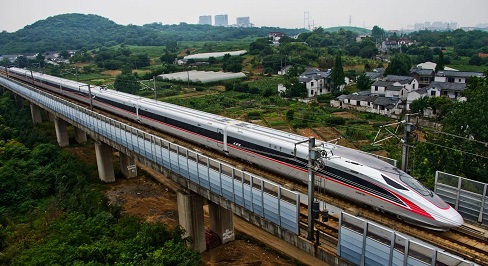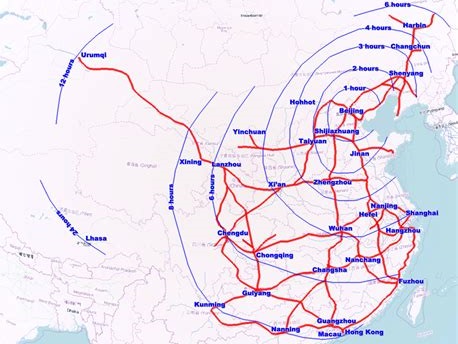Posted On: Friday - August 3rd 2018 3:46PM MST
In Topics: California China Economics Geography

Note first, that Peak Stupidity gives credit where credit is due. I'm pretty impressed with the new infrastructure being built in China, as discussed here. With the 1st line coming into service not more than ~ 10 years ago, China has a network of high speed trains that have turned formerly 24 hour trips, more recently 10 hour trips, into 4-5 hour trips (all by train). Nope, I don't know the details, but some family members have taken a round trip and had nothing bad to say about it.

Now, to continue on with the discussion of California's $80,000,000,000 (or so) San Fran. - LA high-speed rail
Mr. Sailer himself brought up a very good point a number of times. The value of trains, as compared to air travel, is in the ability of a passenger to quickly GET ON the thing. That'd mean it starts and ends in downtowns, and lots of people live in those downtowns. You can't really go to the suburbs and exurbs where lots of Americans live, as, by definition, they are spread out. No matter how fast it can go, a fast train becomes a slow train, if it has to make lots of stops. If passengers have to take a 20 min to 1 hour car ride to the station, this particular advantage over air travel (as planes CAN'T DO THAT... kinda excepting Chicago Midway and a few others) goes away.
Downtown-to-downtown it's gotta be. That brings up the 2nd part of this point. People MUST LIVE downtown, that's lots of people to have enough to fill up these trains for long-distance travel. 100, even 50 years, ago in America, that was the case - oh, and related to that, there were lots of passenger train lines around too! Ever since the black riots of the 60's - 70's in many of the cities, and industry's relocation out of them, people have tended to live farther and farther away (white flight). The heavy use of autos and the interstate beltways may seem to be part of the reason, but I think they are an effect rather than the cause. Excepting the very big cities, NYC, Washington, FS, Chicago, LA, San Fran, Seattle, etc. most American cities don't have many people who live downtown. In many medium-sized cities, one doesn't even go downtown at night for safety reasons. Sure, there are gentrified areas, but the downtowns must have LOTS of people that make money, keep in mind, to support a long-distance rail line. Just like with airline travel, people don't travel that distance daily.
People in the discussion bring up the terrain in California, which, even on the best route (down the SF peninsula into the San Joaquin, aka central valley, and back up through the Grapevine pass into the LA basin), is tougher than that in the only place where trains in America ARE viable and reliable(?), the "Acela corridor" (named after those particular Amtrak trains). Sure, but you've got $80 BILLION to spend. What would the Chinese be able to build for that? They have rough terrain ALMOST ALL OVER that land, as discussed a bit on a post about blackberry picking. This is just a contrast, again, with China being a CAN-DO nation, while America is not at the present time. We sure were before, say, when the transcontinental railroad was built in the 1860's for cryin' out loud, albeit with some Chinese labor. Even if we were, however, the question is, is this California HS train worth being built.
Look at the map above, or some of Western Europe or Japan. There are many big cities, in which, loads of people DO live in the downtowns*. These cities are are spread out nicely in two dimensions (a bit less so in Japan, I suppose) and, most importantly they are not very far apart, compared to the American scale. It'd be something fairly easy to calculate more accurately, but right now, I can pick a number, somewhere near 250 miles, as a distance between terminals in which HS rail travel could easily beat air travel in time. The extra time spent in the air travel mode will be in the trip to/from the airports vs. walking or taking quick bus or subway rides to the big station, and taxi and approach phases of the airline flight, not involved in rail travel. Note, I'm NOT counting the egregious TSA humility and big waste of time, just due to the expectation that the HS rail will have lots of the same. If the train can keep an average of 125 mph (say, full-speed cruise at 140 mph, which is much less than the proposed CA one), that's ~ 2 hours, vs a block time of ~ 1.25 hours in an airline "short hop" like this (but from big hub to 'nother big hub, right?). The train will be a quicker trip.
Now, when you almost double the mileage, as in 400 miles for the LA-SF proposed route, the air travel time does not change much. All the extra mileage for the airplane is cruise flight time. At 450 mph, that extra 150 miles is 20 min extra for the plane, yet 1 hour more for the train (I LUV round numbers!) Let's consider a route from Los Angeles, CA to Denver, Colorado. That's 860 statute miles in a straight line, while the railway would not have a significantly shorter route than the 1,100 miles on the good roads, call it 1000 miles with some good cut-offs. It's gonna take close to 8 hours by high-speed (125 mph average) train. For the flying, we can count up a 45 minute drive, and 45 min of airport crap in LA (remember I'm not counting TSA, as I'd imagine the rail line would have that too before long), 15 min out of the airport and 45 min home in Denver (yeah, the airport is WAY outta town there!) and 15 min airplane taxi time each end with 15 extra minutes of maneuvering coming in. That's 3 1/2 hours + 2 hours of climb/cruise/descent at high speed to make 5 1/2 hours. The rail trip takes more than 50% longer than air travel, even with all the extra trouble involved in flying.
What we have in America, other than in the Washington, FS to Boston, Mass, Acela corridor, is very long stretches between big, downtown-inhabited cities. Even that corridor in the northeast does not make a network, such at the China rail map above, hence the term "corridor". All the cities are in a line.
CAN'T-DO country not-withstanding, that's why high speed rail, and passenger railroad travel in general is not an efficient mode for travel in America. We were the first in creating air travel, and it's been working damn well ever since the DC-3's were the first to make money without depending on the postal service. Before that time, we had the best passenger rail network for a country this size, of course, also. What a CAN-DO country did back 80 years ago(!) was make > 100 mph streamlined 4,000 hp, locomotives, with names like the Hiawatha**, the Commodore Vanderbilt, and the Rexall Mohawk.

(That's 80 years ago - how were the Japanese and Chinese getting around back then?). Once the 707's and DC-8's came along, though, it took just over a decade for passenger-rail to get to the state glorified in song by Mr. Arlo Guthrie in that previous post. Yes, it's sad, and yes rail travel is probably more fun for most of us. You want to have things just for fun, you've got to be rich enough to pay for them.
After all that transportation discussion the reader may well be wondering, "Hey, where's the stupidity?" Oh, yeah, that's right, in California, of course. That's how I got started on this topic.
* The Chinese won't change in this respect (maybe Japanese too), as they LUV, LUV, LUV the bright lights, big city thing. The Europeans may somewhat, but with the way the immigration invasion is going there, they may also feel the need to move out of their downtowns.
** No, nobody had a reason to get buttsore about Indian names back then. What for?
Comments: